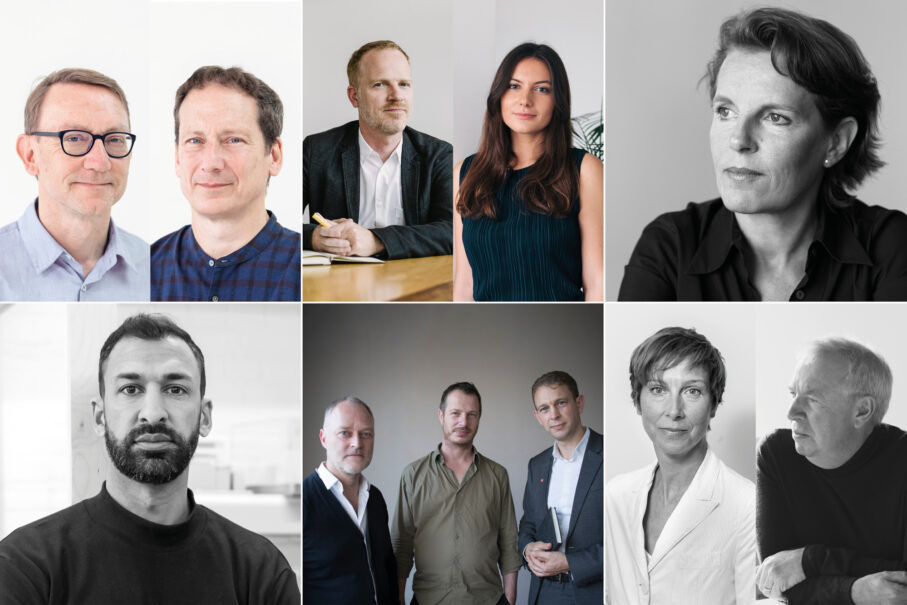
Clockwise from top left: Peter St John and Adam Caruso of Caruso St John © Ben Blossom; David Kohn and Jessica Lyons of David Kohn Architects © Matthew Thompson; Annabelle Selldorf of Selldorf Architects © Brigitte Lacombe; David Chipperfield © David Chipperfield Architects and Lucy Musgrave, Publica © Amandine_Alessandra; Stephen Witherford, Chris Watson and William Mann © WWM Architects; and Asif Khan © Jérémie Souteyrat.
The National Gallery has today (8 April 2021) announced six shortlisted design teams in its search for a partner to work with it on a suite of capital projects to mark its Bicentenary. An initial phase of work will be completed in 2024, to mark the Gallery’s 200th year.
The shortlisted teams are:
- Asif Khan with AKT II, Atelier Ten, Bureau Veritas, Donald Insall Associates, Donald Hyslop, Gillespies, Joseph Henry, Kenya Hara, and Plan A Consultants
- Caruso St John Architects with Arup, Alan Baxter, muf architecture/art and Alliance CDM
- David Chipperfield Architects with Publica, Expedition, Atelier Ten, iM2 and Plan A Consultants
- David Kohn Architects with Max Fordham, Price & Myers, Purcell and Todd Longstaffe‐Gowan
- Selldorf Architects with Purcell, Vogt Landscape Architects, Arup and AEA Consulting
- Witherford Watson Mann Architects with Price and Myers, Max Fordham, Grant Associates, Purcell and David Eagle Ltd
The shortlist has been drawn from an impressive pool of submissions from highly talented UK and international architect-led teams. In addition to members of the executive team and Trustees of the National Gallery, several independent panellists are advising on the selection process, which is being run by Malcolm Reading Consultants. These are Edwin Heathcote, Architecture Critic and Author; leading structural engineer Jane Wernick CBE FREng; and Ben Bolgar, Senior Design Director for the Prince’s Foundation. The extremely high quality of the submissions led the panel to increase the number shortlisted from the originally envisaged five, to six.
Following an open call launched in February 2021, the next steps will require the shortlisted teams to submit an initial tender, attend negotiation workshops, submit a final tender and then be interviewed by the selection panel. No design work will be required, and some expenses will be paid to the shortlisted teams. An appointment is expected to be made in July 2021.
Commenting on the announcement of the shortlisted teams, Director of the National Gallery, Dr Gabriele Finaldi said:
‘We were impressed and delighted with the high quality of the submissions we received. It was not an easy task to reach the shortlist, but we are confident that we have chosen six teams that will produce a range of different approaches to excite and inspire us.
‘This is a significant moment in the development of the National Gallery as we look forward to the recovery of our arts and cultural institutions, our city and our country. It is important that we choose a team who we can work with collaboratively and that shares our vision for the future. I’m looking forward to the next phase of the selection process.’
Paul Gray, Chief Operating Officer of the National Gallery, added:
‘We thank everyone who submitted for the NG200 Project. From these six shortlisted teams, we are looking for demonstrable and exceptional design talent as well as the creativity to respond sensitively to the heritage and context of the Sainsbury Wing. We have identified teams that we know will offer exciting and inspiring visions, and we look forward to working with the winning team to unlock the potential of the spaces within the Sainsbury Wing and the public realm.’
NG200 will celebrate 200 years since the National Gallery’s foundation in 1824, programming a series of inspirational exhibitions and outreach around the country and around the world. The celebration will also include the completion of an initial phase of works to its Trafalgar Square buildings to improve the ‘welcome’ it provides to the millions of visitors it receives each year.
The brief for the project includes sensitive interventions to the Grade I listed Sainsbury Wing to reconfigure the ground- floor entrance and upgrade the visitor amenities, creating new spaces that will provide a welcome experience befitting a world-class institution and that meets the expectations of 21st-century visitors.
A new Research Centre will support the Gallery’s vision of becoming a world leader in research into historic painting, and communicate the Gallery’s work as a global thought leader by creating a powerful resource for studies into art history, digital humanities, conservation, and heritage science. It will be a resource for everyone interested in studying art, from students to international academics.
The successful team will also be asked to reimagine the public realm immediately outside the Sainsbury Wing and along the northern edge of Trafalgar Square to improve the presence of the building in its context and create a more attractive and enjoyable setting for visitors and the public.
Underpinning the brief is the desire to create healthy, sustainable, and accessible spaces and an environment that is open and inclusive where visitors can relax as they plan their visit to one of the world’s finest art collections. Following a year of unprecedented challenges due to Covid-19, the National Gallery wants to build on its strength, inventiveness, and relevance to play a vital role in the nation’s recovery story.

